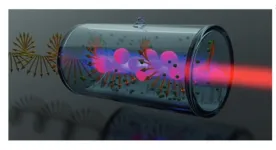(Press-News.org) New research has shed light on how genetics influences the growth of the placenta, revealing a link to risk of disease in the mother.
Scientists from the University of Exeter worked with colleagues in Norway and Denmark to lead a largescale international collaboration which examined placental growth in the greatest detail yet. They caried out the first ever genome-wide association study of the weight of the placenta at birth, generating a number of revelations. Among the findings published in Nature Genetics, the team concluded that faster growth of the placenta can contribute to risk of preeclampsia, and to earlier delivery of the baby.
The placenta is an organ which grows in the womb alongside the foetus, which is attached to it by the umbilical cord. The placenta provides oxygen and nutrients to the growing foetus and removes waste as the baby develops. A poorly functioning placenta is associated with pregnancy complications, and later risk of disease in the child. Despite its key role, little is yet known about how the growth of the placenta is regulated. Understanding placental growth is important, as babies with very small or large placentas are at higher risk of complications.
Professor Pål Njølstad, of the University of Bergen in Norway, who co-led the paper, said: “The placenta is such an important organ during pregnancy, providing an intricate and vital link between mother and baby. Our study has identified 40 variations in the genetic code linked to how big a placenta can grow, which improves our understanding of this vital organ in humans. Several of these genetic variations also influence the weight of the baby, but some appear to be predominantly concerned with placental growth.”
The team found that where the genetic code of the foetus meant it was more likely that the placenta would grow bigger, there was a higher risk of pre-eclampsia in the mother. This could be because the placenta grows too fast, which can upset the balance between the baby’s demand for resources and how much the mother is able to provide, which can be a factor in pre-eclampsia that occurs later in pregnancy.
Professor Rachel Freathy, of the University of Exeter Medical School, who is funded by Wellcome, is a co-lead on the paper. She said: “Pre-eclampsia is a condition that may develop in pregnancy, which causes high blood pressure. Some of the mother’s organs, such as the kidneys and liver, stop working properly. Detecting it early is essential to avoid severe health problems for mother and baby, yet how preeclampsia develops isn’t fully understood. Our study suggests that faster growth of the placenta contributes to a higher risk of preeclampsia in the mother. It seems specific to placenta growth because we did not find the same risk when we looked at the genetics of baby weight.”
Faster-growing placenta was also linked to shorter pregnancy. Senior researcher, group leader Bjarke Feenstra, of Copenhagen University Hospital and Statens Serum Institut, Denmark, who also co-led the study, said: “We found that babies with genetic code for a bigger placenta were more likely to be born earlier, which underscores the importance of investigating placental biology in studies of pregnancy duration and the timing of delivery.”
One key finding from the study related to insulin, which regulates blood sugar. The foetus produces insulin in response to glucose from the mother, which acts as a growth factor. The team found this insulin is also linked to the growth of the placenta, which helps to explain why placentas tend to be large in pregnancies where the mother has high blood glucose due to diabetes.
“While this is a great first step,” said Professor Stefan Johansson, also co-lead at the University of Bergen, “the final weight of a placenta can only tell us a limited amount about its function. Further studies are needed to examine the shape and development of placenta over the course of pregnancy. Our work is just the starting point for future research which could help us understand far more about the placenta’s role in the growth of the baby and risk of pregnancy complications.”
The study involved wider collaboration included scientists from Australia, Canada, the US and elsewhere in Europe. In the UK, it was supported by the National Institute for Health and Care Research Exeter Biomedical Research Centre. The study is entitled “Genome-wide association study of placental weight identifies distinct and shared genetic influences between placental and fetal growth”, and is published in Nature Genetics.
END
New research sheds light on genetics of placenta growth and link to preeclampsia in mother
New research has shed light on how genetics influences the growth of the placenta, revealing a link to risk of disease in the mother
2023-10-05
ELSE PRESS RELEASES FROM THIS DATE:
The medicine of the future could be artificial life forms
2023-10-05
Creating artificial life is a recurring theme in both science and popular literature, where it conjures images of creeping slime creatures with malevolent intentions or super-cute designer pets. At the same time, the question arises: What role should artificial life play in our environment here on Earth, where all life forms are created by nature and have their own place and purpose?
Associate professor Chenguang Lou from the Department of Physics, Chemistry, and Pharmacy, University of Southern Denmark, together with Professor Hanbin Mao from Kent State University, is the parent of a special artificial hybrid molecule that could lead to ...
Scientists discover the highest energy gamma-rays ever from a pulsar
2023-10-05
Scientists using the H.E.S.S. observatory in Namibia have detected the highest energy gamma rays ever from a dead star called a pulsar. The energy of these gamma rays clocked in at 20 tera-electronvolts, or about ten trillion times the energy of visible light. This observation is hard to reconcile with the theory of the production of such pulsed gamma rays, as the international team reports in the journal Nature Astronomy.
Pulsars are the left-over corpses of stars that spectacularly exploded in a supernova. The explosions leave behind ...
Discovery made by University of Warsaw scientists may enable network interface for quantum computers
2023-10-05
A team of scientists at the QOT Centre for Quantum Optical Technologies, including a student from the Faculty of Physics (University of Warsaw), made a device capable of the conversion of quantum information between microwave and optical photons. The results of research, published in “Nature Photonics” magazine, highlight a new microwave detection method with possible applications in quantum technologies, as a part of quantum network infrastructure, and in microwave radio-astronomy.
Conversion of quantum information
Whenever you listen to a song on your phone or computer, a conversion of information happens – ...
Risk of gastrointestinal adverse events associated with glucagon-like peptide-1 receptor agonists for weight loss
2023-10-05
About The Study: This study found that use of glucagon-like peptide-1 agonists for weight loss compared with use of bupropion-naltrexone was associated with increased risk of pancreatitis, gastroparesis, and bowel obstruction but not biliary disease. Given the wide use of these drugs, these adverse events, although rare, must be considered by patients who are contemplating using the drugs for weight loss because the risk-benefit calculus for this group might differ from that of those who use them for diabetes.
Authors: Mahyar Etminan, Pharm.D., M.Sc., of the University of British Columbia in Vancouver, is the corresponding author.
To access the embargoed study: Visit ...
UK study shows hybrid closed-loop technology improved maternal glucose levels during pregnancy complicated by type 1 diabetes
2023-10-05
For pregnant women with type 1 diabetes, a technology giving insulin doses, as informed by a smartphone algorithm, helps them better manage their blood sugars compared with traditional insulin pumps or multiple daily injections, according to a new randomised trial published in The New England Journal of Medicine (NEJM) and presented at the European Association for the Study of Diabetes (EASD) meeting in Hamburg (2-6 October).
Despite better systems for monitoring blood sugars and delivering insulin, hormonal changes and altered eating patterns during pregnancy mean that ...
Successful morphing of inorganic perovskites without damaging their functional properties
2023-10-05
A research team co-led by scholars from City University of Hong Kong (CityU) has successfully morphed all-inorganic perovskites at room temperature without compromising their functional properties. Their findings demonstrate the potential of this class of semiconductors for manufacturing next-generation deformable electronics and energy systems in the future.
All-inorganic lead halide perovskites are becoming increasingly important semiconducting materials in energy conversion and optoelectronics because of their outstanding performance and enhanced environmental stability.
“However, unlike metal ...
MD Anderson launches collaborative initiative to reduce breast cancer disparities in Houston area
2023-10-05
HOUSTON ― The University of Texas MD Anderson Cancer Center today announced the launch of Texas Health Equity Alliance for Breast Cancer (THEAL), a community-wide health care initiative to reduce breast cancer disparities in the Houston area, particularly for Black women.
THEAL builds upon the expertise of MD Anderson’s Department of Health Disparities Research in addressing the determinants of cancer disparities while leveraging the cancer prevention and control platform’s experience in leading cross-sector collaboratives ...
In checking chess’s gender bias, researchers find parents and mentors shortchange girls’ potential
2023-10-05
“The Queen’s Gambit” miniseries portrayed the life of a fictional chess prodigy, Beth Harmon, who is continuously underestimated in male-dominated competitions. A team of New York University psychology researchers has now found some “real-life” evidence of what Harmon faced as a younger player: Parents and coaches of youth chess players peg the highest potential rating of girl players to be lower than that of boy players.
Moreover, the study’s authors, who included Jennifer Shahade, a two-time US Women’s Chess champion, found ...
Female chess players may experience gender bias from parents, mentors
2023-10-05
Young female chess players often face gender bias both in the male-dominated chess world and among parents and mentors who believe girls have less potential to succeed in chess than boys, according to research published by the American Psychological Association.
“It’s disheartening to see young female players’ potential downgraded, even by the people who are closest to them, like their parents and coaches,” said lead researcher Sophie Arnold, a doctoral student at New York University.
The study, which was published online in the Journal of Experimental Psychology: General, presents what the researchers say is the first large-scale ...
US cancer centers continue to see chemotherapy shortages, according to update from NCCN
2023-10-05
PLYMOUTH MEETING, PA [October 5, 2023] — The National Comprehensive Cancer Network® (NCCN®)—a non-profit alliance of leading cancer centers across the United States—has released a follow-up survey on the ongoing chemotherapy shortages: 72% of the centers surveyed continue to experience a shortage of carboplatin and 59% are still seeing a shortage of cisplatin. Overall, 86% of centers surveyed reported experiencing a shortage of at least one type of anti-cancer drug.
View the updated survey results at NCCN.org/platinum-update.
The NCCN Best Practices Committee originally shared survey results ...
LAST 30 PRESS RELEASES:
Longest observation of an active solar region
Why nail-biting, procrastination and other self-sabotaging behaviors are rooted in survival instincts
Regional variations in mechanical properties of porcine leptomeninges
Artificial empathy in therapy and healthcare: advancements in interpersonal interaction technologies
Why some brains switch gears more efficiently than others
UVA’s Jundong Li wins ICDM’S 2025 Tao Li Award for data mining, machine learning
UVA’s low-power, high-performance computer power player Mircea Stan earns National Academy of Inventors fellowship
Not playing by the rules: USU researcher explores filamentous algae dynamics in rivers
Do our body clocks influence our risk of dementia?
Anthropologists offer new evidence of bipedalism in long-debated fossil discovery
Safer receipt paper from wood
Dosage-sensitive genes suggest no whole-genome duplications in ancestral angiosperm
First ancient human herpesvirus genomes document their deep history with humans
Why Some Bacteria Survive Antibiotics and How to Stop Them - New study reveals that bacteria can survive antibiotic treatment through two fundamentally different “shutdown modes”
UCLA study links scar healing to dangerous placenta condition
CHANGE-seq-BE finds off-target changes in the genome from base editors
The Journal of Nuclear Medicine Ahead-of-Print Tip Sheet: January 2, 2026
Delayed or absent first dose of measles, mumps, and rubella vaccination
Trends in US preterm birth rates by household income and race and ethnicity
Study identifies potential biomarker linked to progression and brain inflammation in multiple sclerosis
Many mothers in Norway do not show up for postnatal check-ups
Researchers want to find out why quick clay is so unstable
Superradiant spins show teamwork at the quantum scale
Cleveland Clinic Research links tumor bacteria to immunotherapy resistance in head and neck cancer
First Editorial of 2026: Resisting AI slop
Joint ground- and space-based observations reveal Saturn-mass rogue planet
Inheritable genetic variant offers protection against blood cancer risk and progression
Pigs settled Pacific islands alongside early human voyagers
A Coral reef’s daily pulse reshapes microbes in surrounding waters
EAST Tokamak experiments exceed plasma density limit, offering new approach to fusion ignition
[Press-News.org] New research sheds light on genetics of placenta growth and link to preeclampsia in motherNew research has shed light on how genetics influences the growth of the placenta, revealing a link to risk of disease in the mother



